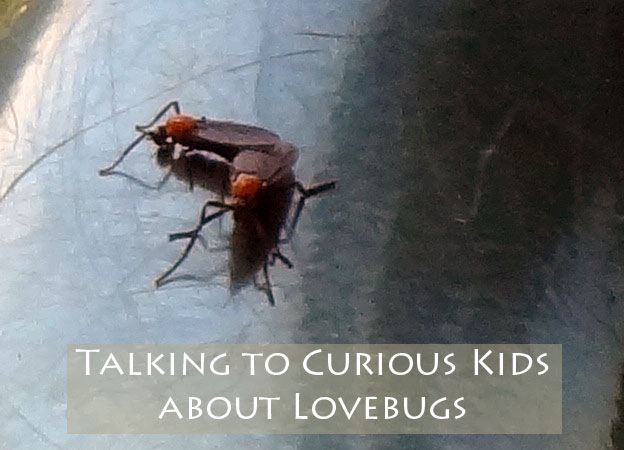Talking to Curious Kids about Lovebugs and Other Critter Pairs
May and September are known for their “lovebugs” in the southeast part of the US. It is often difficult to drive without running into a swarm of them. Other than the splats they cause on your vehicles, they are essentially harmless. However, they do bring up questions by many curious kids. Why does that bug have two heads? Why is there two of them? Why are they connected together? Similar questions are asked when children see any mating pair – frogs and lizards are two other very popular question makers.
How would you answer your curious kids? Does your answer depend on the child’s age? What if the child is not yours but a friend’s? This was a dilemma my husband and I faced when we took our friends’ kids to the playground to play with Aiden one day. We were exploring the wildlife around the playground.
We saw birds fighting for territories. Why are the birds fighting? The birds are most likely male birds arguing over space. They are fighting over where the “fence” between their yards is. Why are they doing that? So they can find a mate (kind of like a wife), to build a nest, and have baby birds. Oh… No problems there. Next, I see a pair of lizards mating. I thought about pointing out the lizard pair, but I decided against because I was unsure of how to explain it the children {friends’ children are ages 6 and 3}. Then, we start observing the lovebugs. They are simply everywhere and impossible not to notice. Aiden and the 3 year old don’t ask any questions – they’re just having fun looking for lizards and watching the lovebugs fly around everywhere. The 6 year old asks, why do they look like that; are there two of them? Yes. There are two. Why are there two? Why are they stuck together? I was thinking of how best to explain this to the 6 year old in a way she could understand. Patrick is thinking the same thing. He simply says, that’s a good question, you should ask your parents.
Naturally, the curious 6 year old does just that. So what does her mom say? Her mom is honest and tells her that the lovebugs are mating and will eventually have babies. Oh. No more questions for the day.
I asked my blog friends if they had any similar stories to share. How do you explain mating critters?
Jackie from Happy Hooligans shared this about toads mating in her pond:
That’s always big excitement at our house for the daycare children (ages 1-5). As soon as they see the two toads together, they know the eggs will soon follow. I have always explained that they are mating; that the female is laying her eggs, and the male is fertilizing them. It’s an accurate description – they get the facts and the technical terms and it’s always satisfied their curiosity – they’ve never asked for further explanation. It’s pretty cute when their parents or other daycare kids arrive, and they’re calling out, “Come and look! The toads are mating!!” They’re just so excited that it’s just a matter of time before we have tadpoles. I think that explanation would work well for insects, birds, other reptiles too.
Charlotte from Make, Do and Friend and her son (age 2 1/2) recently saw a pair of ladybirds mating. Her son said they were “piggybacking.” Charlotte responded, “hmm I hope they’re enjoying themselves, let’s get them some privacy.”
Adrienne from The Iowa Farmer’s Wife told of her daughter (age 3) who saw two lizards together. She said, “Look it’s a mama and a baby on her back!” Adrienne simply replied, “Oh it does look like a mama and a baby on her back!”
Jane from Mama Pea Pod shared these two stories:
I had a first grade student excitedly tell me that there were two firebugs “marrying” in the playground. She thought it was very romantic. I didn’t explain anything to her since she wasn’t my own child and I wasn’t sure what her parents had told her. My own daughter saw pandas mating at the zoo when she was 2 1/2. Since it’s very rare for pandas to mate in captivity, it was a really big deal and all the zoo staff came running with their telephoto lens cameras, so she could tell there was something special about what the pandas were doing. We told her they were making babies. She was very interested, particularly as we’d just told her that there was a baby in mummy’s tummy, so she watched closely, with great interest. She didn’t ask any further questions about how it worked other than why they were making so much noise (they were grunting *very* loudly, and she’s rather scared of loud noises, so she was a bit concerned about the noise!), so we didn’t tell her any more at that point, but it was a memory that she came back to often throughout my pregnancy as a point of reference. Oh, and the following spring we went back to the zoo and she saw the baby panda, and remembered that she had seen when the panda was getting made.
Children are naturally curious. The biology teacher in me says teach them about their world and help foster their curious nature. Ultimately, it’s up to your comfort level and what you think the situation warrants. There will always be plenty of future instances to explain their observations.


Leave a Reply